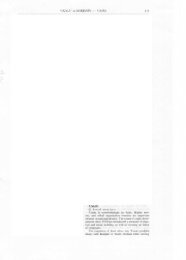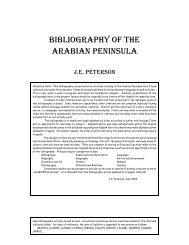THE ARABIAN PENINSULA IN MODERN TIMES: A - JEPeterson.net
THE ARABIAN PENINSULA IN MODERN TIMES: A - JEPeterson.net
THE ARABIAN PENINSULA IN MODERN TIMES: A - JEPeterson.net
Create successful ePaper yourself
Turn your PDF publications into a flip-book with our unique Google optimized e-Paper software.
Coast” (and which later became known as the Trucial Coast). This subject was covered in earlier<br />
years but Mubarak al‐Otabi and Charles E. Davies add new light. British activity in Saudi Arabia<br />
fell into the category of military assistance, which Joseph Kostiner examines for the period of<br />
the 1930s and Nikolas Gardner discusses for the period of the 1960s‐1970s. The insertion of<br />
British troops into Kuwait when Iraq seemed to threaten that country upon its independence in<br />
1961 has been treated in the past but Nigel Ashton reviews the topic. Another side of British<br />
security concerns involved internal developments in the Gulf states and the emergence of<br />
opposition movements perceived as radical threats, as Miriam Joyce describes in the case of<br />
Bahrain in the 1950s. 69 A few studies look at the security scene from a broader point of view:<br />
Rod Thornton describes British strategy in countering Arab insurgencies and William Roger<br />
Louis adds what must be hoped is the final coda on British withdrawal. 70<br />
It was, after all, British withdrawal in 1971 that sparked American interest in “protecting”<br />
the Gulf, even if that interest did not translate into direct action for a decade or more to come.<br />
Certainly, the United States had official interests well before 1971, as Moiara de Moraes<br />
Ruehsen, William Fain, Reuven Hollo, Michael Palmer, and Gary Sick demonstrate, while Fred<br />
Lawson discusses the US position vis‐à‐vis opposition movements in the region. 71 But the<br />
transition from a British umbrella to an American one was not smooth and the two powers<br />
clashed discreetly over al‐Buraymi Oasis and Kennedy’s recognition of the Yemen Arab Republic<br />
in 1962, among other points of tension. The intertwining of Anglo‐American interests in the<br />
Gulf during the 1940s through the 1960s has been studied by Simon Davis, Taylor Fain, Tore<br />
Tingvold Petersen, and Miriam Joyce. 72<br />
69. Mubarak al-Otabi, “The Qawasim and British Control of the Arabian Gulf” (Ph.D. thesis, University of Salford,<br />
1989); Charles E. Davies, The Blood-Red Flag: An Investigation into Qasimi Piracy, 1797-1820 (Exeter, UK:<br />
University of Exeter Press, 1997); ibid., “Britain, Trade and Piracy: The British Expeditions Against Ra’s al-<br />
Khaima of 1809-10 and 1819-20” in Charles E. Davies, ed., Global Interests in the Arab Gulf (Exeter: University of<br />
Exeter Press, 1992), pp. 29-66; Joseph Kostiner, “Britain and the Challenge of the Axis Powers in Arabia: The<br />
Decline of British-Saudi Cooperation in the 1930s,” in Michael J. Cohen and Martin Kolinsky, eds., Britain and the<br />
Middle East in the 1930s: Security Problems, 1935-39 (Houndmills, UK: Macmillan, 1992), pp. 128-143; Nigel<br />
Ashton, “A Microcosm of Decline: British Loss of Nerve and Military Intervention in Jordan and Kuwait, 1957 and<br />
1961,” Historical Journal, Vol. 40, No. 4 (1997), pp. 1069-1083; Miriam Joyce, “The Bahraini Three on St. Helena,<br />
1956-1961,” Middle East Journal, Vol. 54, No. 4 (Autumn 2000), pp. 613-623; Nikolas Gardner, “The Harold<br />
Wilson Government, Airwork Services Limited, and the Saudi Arabian Air Defence Scheme, 1965-73,” Journal of<br />
Contemporary History, Vol. 42, No. 2 (April 2007), pp. 345-363.<br />
70. William Roger Lewis, “The British Withdrawal from the Gulf, 1967-71,” Journal of Imperial and<br />
Commonwealth History, Vol. 31, No. 1 (2003), pp. 83-108; Rod Thornton, “Countering Arab Insurgencies: The<br />
British Experience,” Contemporary Security Policy, Vol. 28, No. 1 (April 2007), pp. 7-27.<br />
71. Moiara de Moraes Ruehsen, “The Advent of American Hegemony in the Persian Gulf, 1953-1956” (Ph.D.<br />
dissertation, Johns Hopkins University SAIS, 1992); Fred H. Lawson, Opposition Movements and U.S. Policy<br />
Toward the Arab Gulf States (New York: Council on Foreign Relations Press, 1992); Michael A. Palmer,<br />
Guardians of the Gulf: A History of America’s Expanding Role in the Persian Gulf, 1833-1992 (New York: Free<br />
Press, 1992); Reuven Hollo, “Oil and American Foreign Policy in the Persian Gulf (1947-1991)” (Ph.D. dissertation,<br />
University of Texas at Austin, 1995); William Taylor Fain, III, “Toll-Gates and Barbicans of Empire: The United<br />
States, Great Britain, and the Persian Gulf Region, 1950-1968” (Ph.D. dissertation, University of Virginia, 2002);<br />
Gary Sick, “The United States and the Persian Gulf in the Twentieth Century,” in Lawrence G. Potter, ed., The<br />
Persian Gulf in History (New York: Palgrave, 2009), pp. 295-310. For more on dissidence in the Peninsula, see<br />
Joseph A. Kechichian, Extremism and Opposition Movements on the Arabian Peninsula (New Delhi: Observer<br />
Research Foundation, 2006).<br />
72. Tore Tingvold Petersen, “Anglo-American Rivalry in the Middle East”; Simon Davis, “Keeping the Americans<br />
in Line? Britain, the United States, and Saudi Arabia, 1939-1945: Inter-Allied Rivalry in the Middle East<br />
22







